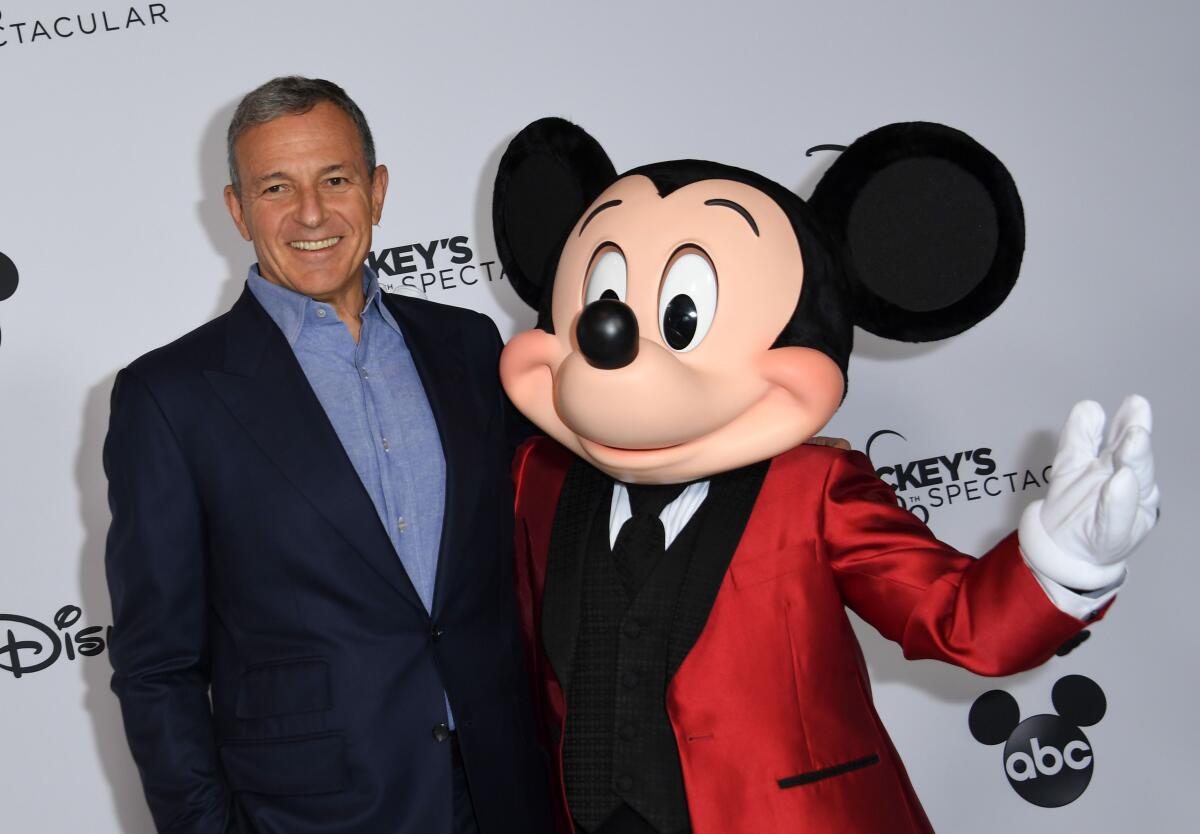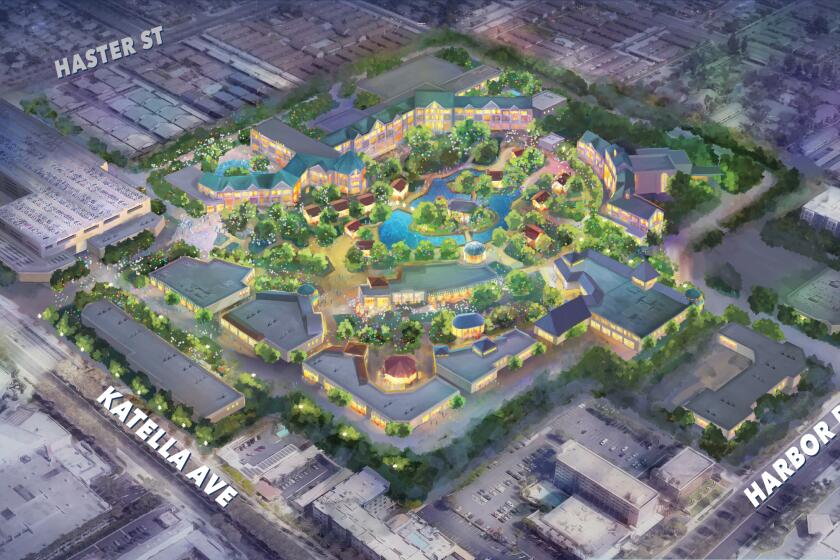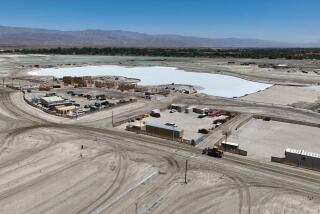Column: Disneyland has already turned my hometown into a giant tourist trap. What’s next?

Somewhere in my personal papers is a folded up, tattered poster of Mickey Mouse commemorating his long reign as the world’s most famous rodent. It shows scenes from some of his iconic shorts — “Steamboat Willie,” “The Band Concert,” “Brave Little Tailor” — above the legend “Thanks Mickey for 60 Years!”
Signed, Disneyland.
My fourth-grade classmates and I received the posters in the fall of 1988 at Patrick Henry Elementary School in Anaheim, along with a T-shirt of a tuxedoed Mickey wearing sneakers and a free trip to the Happiest Place on Earth for his birthday bash. We cheered alongside kids from around the world and rode rides until the evening. I can still hum parts of the gratingly cheery song from the parade held in Mickey’s honor. (A quick YouTube search confirmed I have the melody right.)
The poster hung on my wall through junior high, even though I was more of a Donald Duck fan. It was a symbol for me that a company whose products and productions I loved cared about us Anaheim kids. How cool was it that one of the world’s most popular theme parks was in my hometown? And how cool was it that they let us kids hang out with Mickey on his birthday for free?
The Anaheim Planning Commission voted Monday night to approve the DisneylandForward project, which would clear the path for major park development.
I hadn’t thought about my souvenir for decades until yesterday, when the Anaheim City Council passed yet another Disneyland-friendly ordinance. Zoning regulations will be relaxed so Disney can build new attractions and hotels on its 490-acre campus, and three public roads will be sold to Disney for $40 million.
In return, Disney promises to undertake nearly $2 billion in construction over the next decade, donate $30 million to a yet-to-be-formed public housing trust run by Anaheim, give $8 million toward improving city parks and pay $45 million in “transportation improvements,” according to the website for DisneylandForward, the name Disney has bestowed on its plans.
A Disney-funded study by Cal State Fullerton’s Woods Center for Economic Analysis and Forecasting predicted that the company’s most ambitious proposals — a full build-out of Disneyland and Disney California Adventure, and a new hotel — will create tens of thousands of jobs and generate $244 million in annual tax revenue.
Who could possibly be against this windfall of cash and fun? Me, of course!
The Anaheim City Council unanimously approved the agreement despite the lack of concrete plans from Disney — all it’s revealing right now is “possibilities” inspired by attractions from its theme parks worldwide, according to the DisneylandForward website. There might be more specifics in the Woods Center forecast, but city officials and the public alike can see only a nine-page summary because Disney claims it contains proprietary information.
This cryptic Mouse long ago replaced the Mickey of my childhood memories. By the time I became a reporter, I knew that Disney has long treated Anaheim as a political chamois, looking to squeeze as much as possible out of Orange County’s largest city.

In 1996, the city paid for a $108.2-million parking structure — at the time, the largest in the world — that it leases to Disney for a buck a year, allowing the company to keep all the revenue and eventually assume ownership. A 2017 Times analysis found that Disney had “secured subsidies, incentives, rebates and protections from future taxes” worth more than $1 billion over the previous two decades. Disney has repaid that goodwill with millions of dollars in donations to political action committees that push pro-Mickey candidates.
Two years ago, FBI agents and city-funded independent investigators characterized a Disneyland Resort lobbyist as part of a “cabal” that has undue influence over city politics. Meanwhile, the cost of a one-day pass to the Mouse House has increased from $43 in 2000 to $194 as of last year. Nightly fireworks at the resort scare dogs, set off car alarms in working-class neighborhoods and make the 5 Freeway a smoky mess.
Yet, to paraphrase the most famous quote in “The Usual Suspects,” the greatest trick Disney ever pulled was convincing Anaheimers that its bad side doesn’t exist. The few DisneylandForward skeptics have been easily drowned out by supporters.
Unions? Leaders showed up to support DisneylandForward when the Anaheim City Council first voted on it in April. The council? From Republican Stephen Faessel to progressive Carlos Leon to independent Jose Diaz, they hardly asked any hard-hitting questions. The millions of visitors to the Disneyland Resort, half of whom seem to be my cousins and friends? They’re celebrating like Ewoks at the end of “Return of the Jedi” at the thought of more rides to enjoy and swag to grab.
A few hours after the gates swing open at Disneyland and Disney California Adventure, the cars are still pouring into the massive 10,241-space parking garage.
Only a few of us cranks are pointing to the environmental impact report finding that the construction noise and permanent change in air quality as a result of the expansion would be “significant and unavoidable.” Or pulling out a calculator to crunch the numbers in the Woods Center report.
For instance, the study says that if Disneyland maximizes its acreage and builds a new hotel, that will create 28,352 jobs, translating into $1.8 billion in income for those employees.
Sounds nice and big. But it doesn’t say what kind of jobs and whether they’d be permanent or full time. The $63,487 average yearly salary from those jobs is considered low-income for a one-person household in Orange County, according to the California Department of Housing and Community Development. These are hardly the jobs Anaheimers need to be able to afford to live here, let alone live a good life.
I still remember when Anaheim was a city of factories and blue-collar jobs that allowed my immigrant elders and my cousins to buy homes. Near the granny flat where I lived before transferring to Patrick Henry were a lumberyard, a Kwikset factory and a trucking depot where my dad would pick up cargo containers.
All those places vanished decades ago. Now, there are hipster hangouts, beer gardens and high-priced apartments, because Anaheim leaders took Disney’s lead and transformed my hometown into one giant tourist trap, with longtime residents little better than an afterthought.
Which brings me back to that Mickey Mouse 60th anniversary poster. I eventually took it down because the edges were fraying, and I thought it would be a collectors’ item one day. I thought Disneyland had bestowed on me yet another wonderful prize.
I looked up the poster on eBay recently. I can get one for $20. But, hey: At least I got something free from Disney back in the day.
In 2016, the company vowed to give all Anaheim sixth-graders free Disneyland tickets in honor of its 60th anniversary if they did community service projects.
The promotion was supposed to continue for a decade but was discontinued in 2021, during the pandemic. It has yet to be reinstated, even though Disney just announced that its theme park division increased revenue in the second fiscal quarter to $8.39 billion.
Stay classy, Mouse House!
More to Read
Sign up for Essential California
The most important California stories and recommendations in your inbox every morning.
You may occasionally receive promotional content from the Los Angeles Times.












